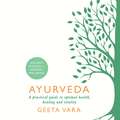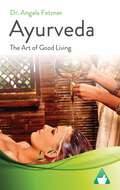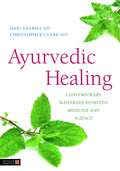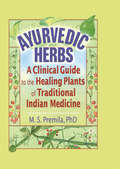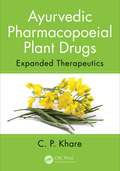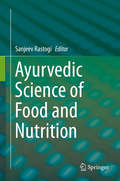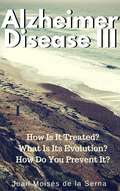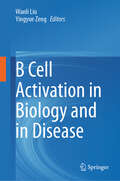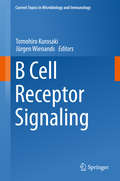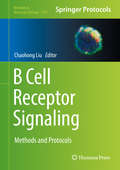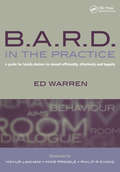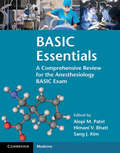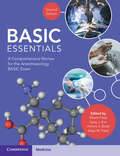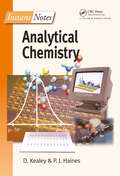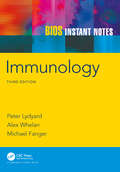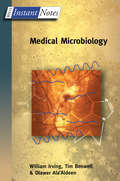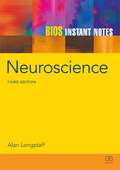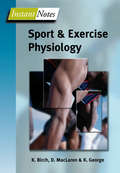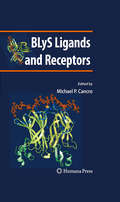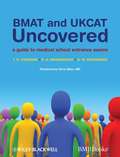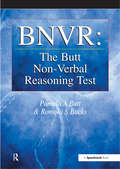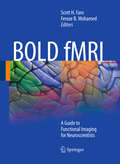- Table View
- List View
Ayurveda: Ancient wisdom for modern wellbeing
by Geeta VaraAyurveda is the oldest known medical science, taking a total holistic approach to life and wellbeing. It brings equilibrium by diving deep into gut health and balancing the three energy forces known as 'doshas'. These doshas give rise to your unique physical, emotional, and mental characteristics.Ayurveda: Ancient Wisdom for Modern Wellness teaches us to reconnect with our natural bio-circadian rhythms and nurture our intimate relationship with nature. The simple, daily applicable wisdom of Ayurveda can help lead you out of the doctor's surgery and on a journey towards self-healing. Expert practitioner Geeta Vara reveals a holistic approach to healthcare that can be customised for you. The book focuses on food as medicine, detoxification, movement, meditation, natural store cupboard remedies and daily rituals that you will love.With this book you can:· Discover your mind/body type · Get to know the impact of your digestion on your wellbeing · Learn tips to take care of your gut health· Be empowered to take a personalised approach to healthcare · Recognise the early sign and symptoms of health issues so that you can keep your mind, body and soul healthy and vibrant· Be inspired to transform your diet through taste not calories· Identify and understand the root cause of your health issues· Address ongoing health issues from stress and fatigue, to immune system issues, gastro-intestinal problems, disturbed sleep, headache/migraine, weight management· Future-proof your wellbeing the way nature intendedRead by Geeta Vara(p) 2018 Orion Publishing Group
Ayurveda: The Art of Good Living
by Dr Angela FetznerThe Art of Good Living Book Description: In recent years, Ayurveda has been gaining increasing popularity in the West. Originating in India, the world's oldest system of medicine is a holistic way of life that teaches how to preserve health, vitality, and joy throughout one's advanced years. Introductory price for the new edition of the e-book: €3.99 instead of the later €5.99. In this regard, health can only be achieved through the balance of body, mind, and spirit. The goal is a long life free from illness and infirmity, instead rich in inner happiness, vitality, and well-being. This easily understandable guidebook aims to serve the reader as an introduction to the fascinating world of Ayurveda – for exploration, inspiration, and implementation. The book demonstrates how one can integrate the principles of Ayurveda into daily life and enhance health and well-being, as well as achieve or regain inner balance. As a seasoned pharmacist with a doctoral degree, the author has been advising and educating numerous customers for over two decades. As an independent author and pharmacist, the author of this book is solely committed to the health and well-being of individuals.
Ayurvedic Healing
by Christopher Clark Hari SharmaAyurveda is one of the World's oldest and most comprehensive systems of natural medicine, and is particularly useful for addressing the chronic conditions Western medicine finds difficult to treat. This authoritative book provides a comprehensive introduction to Ayurvedic medicine for the practitioner or student. The authors describe the foundations and principles of Maharishi Ayurveda in detail, and drawing on the latest scientific research into its efficacy, show what it can offer clinical medicine in the West. Topics covered include pathogenesis and diagnosis, diet and digestion, toxic build-up, purification therapies, the effects of the emotions and thinking on health, and the practical applications of Transcendental Meditation. This updated and expanded second edition describes specific Ayurvedic treatments for a range of common medical conditions, and also contains information on more general Vedic approaches to health and wellbeing. This book will provide complementary and alternative health practitioners with a solid base on which to build their understanding of Maharishi Ayurveda, and will also be of interest to mainstream health professionals wishing to learn more about the efficacy of this ancient healthcare system.
Ayurvedic Herbs: A Clinical Guide to the Healing Plants of Traditional Indian Medicine
by Virginia M Tyler M.S. PremilaA single-source reference on the most important and best-investigated Ayurvedic herbs This book examines the clinical information available on more than 60 Ayurvedic herbs to determine how their use in traditional Indian medicine is supported by modern scientific study. Plants are grouped according to body systems and each entry includes a description, information on the source plant, distribution and traditional use, active chemical constituents, relevant pharmacology, and details of clinical studies and safety findings. This unique book also includes a brief history of Ayurveda, examines the history of drug development and evaluation in ancient India, and identifies current trends resulting from scientific investigation. Worldwide interest in Ayurveda is growing quickly, especially in the United States, Europe, and Japan. But until now, information on Western-style clinical trials on Ayurveda herbs has been scattered and no single source for descriptions, comments, and references has existed. Ayurvedic Herbs presents the first critical validation of Ayurvedic medicine, extensively referenced for physicians and clinicians interested in alternative and adjunctive therapies. This unique book is essential for making informed choices on herb use, offering clinical trial data, results of pharmacological studies, and safety information.Ayurvedic Herbs examines: gastrointestinal agents hepatoprotective agents respiratory tract agents cardiovascular drugs urinary tract drugs antirheumatic agents skin and trauma care agents gynecological agents antidiabetic agents CNS agents rasayana drugs dental and ophthamological agents and much moreAyurvedic Herbs includes cross-references to chapters when a particular plant has more than one indication and watercolor illustrations of twelve major herbs.
Ayurvedic Pharmacopoeial Plant Drugs: Expanded Therapeutics
by C. P. Khare"This kind of systematic work is exactly what is needed for people to help bridge traditional Ayurvedic practice with modern science." Venkatraman Ramakrishnan, Nobel laureate, current president of the Royal Society and group leader at the Medical Research Council Laboratory of Molecular Biology, Cambridge Biomedical Campus, UKAyurvedic Pharmacopoe
Ayurvedic Science of Food and Nutrition
by Sanjeev RastogiAyurveda is widely considered to be one of the oldest health care traditions still in practice today. Originating in India over 3,000 years ago, it is now increasingly recognized and practiced globally including in many European countries and the United States. Food and nutrition play a crucial role in the health care wisdom of Ayurveda. The Ayurvedic Science of Food and Nutrition discusses the various principles of healthy eating as prescribed by Ayurveda. Divided into three sections, it addresses the fundamentals, the clinical applications, and the future challenges of Ayurveda. Specifically, the book discusses issues such as the concept of diet, the use of food as medicine, especially to treat diabetes and cancer, convalescent food practices, and fasting therapy. The Ayurvedic Science of Food and Nutrition is unique in that it is one of the only books to investigate the scientific rationale behind Ayurveda, enabling this health care tradition to potentially be incorporated into a Western clinical practice model when this latter conventional therapy is found to be ineffective.
Azheimer Disease III How is it treated? What is its evolution? How do you prevent it?
by Juan Moises de la Serna Jeannette AntezanaAlzheimer’s has spread, no one can stop it. To the family it has come, it’s thinking about staying. There are pieces of advice to follow, of those who know well The specialist says it; it’s for your own good Little by little, the cruel disease progresses Put it back as you can, they can help you today --- LOVE ---
Aṣṭāṅgahṛdaya: A Scientific Synopsis of the Classic Ayurveda Text
by D. Suresh Kumar G.R. Arun Raj N.K.M. IkbalWorldwide interest in Ayurveda is on the rise, ever since the World Health Organization adopted the Alma Ata Declaration in 1978. Ayurveda is increasingly being adopted and many phytotherapy schools in Europe and the Americas teach Ayurveda as a wellness system. Considering the prominent position that Aṣṭāṅgahṛdaya occupies in Ayurveda, a scientific synopsis of this masterpiece is now presented before the world of Ayurveda. In eight comprehensive chapters, Aṣṭāṅgahṛdaya: A Scientific Synopsis of the Classic Ayurveda Text presents a lucid summary of the teachings of Vāgbhaṭa. Ayurvedic view of the human body, basic principles of Ayurveda, surgical armamentarium, diagnosis and treatment of diseases, herbs and other medicinal substances used in the preparation of various dosage forms, ayurvedic pharmaceutialcs, ayurvedic approach to food fortification, salient features of Aṣṭāṅgahṛdaya and a roadmap for the future are among the topics discussed. Key Features: Presents the ayurvedic view of conception and the human body. Discusses aspects of ayurvedic pharmaceuticals. Examines diagnosis of diseases, lines of treatment, prognosis of diseases, signs of imminent death, management of mishaps and treatment of new diseases. The voluminous information pertaining to the subjects of the various chapters is presented in the form of many tables for ready reference and quick survey. This book provides a helping hand to those interested in rediscovering the teachings of Vāgbhaṭa and is a great resource for researchers of medicine, traditional and alternative medicine, pharmacology and drug discovery.
B Cell Activation in Biology and in Disease
by Wanli Liu Yingyue ZengThis book intends to introduce the basic concepts of B cell activation and its latest advances in biological research and disease treatment applications, including the structure and classification of B cell receptors, the process and mechanism of antibody-mediated B cell activation, and tumour immunity and monoclonal antibody therapies. The book is likely to be of interest to university researchers and graduate students in immunology who wish to learn about the core principles, methods and application of B cell activation, and medical practitioners working on tumour immunotherapy.
B Cell Receptor Signaling (Current Topics in Microbiology and Immunology #393)
by Tomohiro Kurosaki Jürgen WienandsThisvolume details our current understanding of the architecture and signalingcapabilities of the B cell antigen receptor (BCR) in health and disease. Thefirst chapters review new insights into the assembly of BCR components andtheir organization on the cell surface. Subsequent contributions focus on themolecular interactions that connect the BCR with major intracellular signalingpathways such as Ca2+ mobilization, membrane phospholipidmetabolism, nuclear translocation of NF-kB orthe activation of Bruton's Tyrosine Kinase and MAP kinases. These elementsorchestrate cytoplasmic and nuclear responses as well as cytoskeleton dynamicsfor antigen internalization. Furthermore, a key mechanism of how B cellsremember their cognate antigen is discussed in detail. Altogether, the discoveriespresented provide a better understanding of B cell biology and help to explainsome B cell-mediated pathogenicities, like autoimmune phenomena or theformation of B cell tumors, while also paving the way for eventually combating thesediseases.
B Cell Receptor Signaling: Methods and Protocols (Methods in Molecular Biology #1707)
by Chaohong LiuThis volume looks the current advanced protocols used to study aspects of the B cell receptor (BCR). The chapters in this book cover topics such as the mutant of BCR repertoire to understand antibody evolution; interactions between B cells and viruses; mechanical force during BCR activation; B cell signaling using flow cytometry; confocal microscopy, total internal reflection microscopy and intravital two-photon microscopy; and the methods used to study critical cell components related with B cell activation. Written in the highly successful Methods in Molecular Biology series format, chapters include introductions to their respective topics, lists of the necessary materials and reagents, step-by-step, readily reproducible laboratory protocols, and tips on troubleshooting and avoiding known pitfalls. Cutting-edge and practical, B Cell Receptor Signaling: Methods and Protocols is a valuable resource for everyone in the scientific community currently working in the B cell field.
B-Cell Receptor Signaling: Methods and Protocols (Methods in Molecular Biology #2909)
by Palash Chandra MaityB-lymphocytes produce antibodies, mediate humoral responses, and act as a key to the adaptive immune system of our body. The development and function of B cells are largely dependent on B cell antigen receptors (BCRs), which transmit a multitude of signals upon binding to the cognate antigen and activate the survival, proliferation, and differentiation of B cells thereof. Thus, studying the BCR signaling remains fascinating for both basic and translational research. This volume provides a collection of protocols ranging from classical cell and molecular biology applications to state-of-the-art omics techniques for studying BCR signaling. Written in the highly successful Methods in Molecular Biology series format, chapters detail the strengths, weaknesses, and troubleshooting techniques that we hope will be helpful to researchers. Cutting-edge and thorough, B-Cell Receptor Signaling: Methods and Protocols will inspire immunologists in designing new experiments to explore the classics from a different perspective, as well as ask some stunning biological questions of our time.
B.A.R.D. in the Practice: A Guide for Family Doctors to Consult Efficiently, Effectively and Happily
by Ed WarrenForewords by Mayur Lakhani, Mike Pringle and Philip R Evans Respectively Chairman of Communications and Publishing, Royal College of General Practitioners, London; Head of School and Professor of General Practice, University of Nottingham; Former President of WONCA Region Europe. This groundbreaking book describes a completely new approach to the medical consultation, focusing on four key points: Behaviour, Aims, Room and Dialogue (B.A.R.D.). This practical approach has gained support from the Royal College of General Practitioners and reflects the way real family doctors consult in the real world, to the benefit of both the practitioner and the patient. Practical suggestions are made throughout the guide, with training exercises to aid in application. B.A.R.D in the Practice provides important reading for all general practitioners and general practitioner registrars.
BASIC Essentials: A Comprehensive Review for the Anesthesiology BASIC Exam
by Alopi M. Patel Himani V. Bhatt Sang J. KimFocused and results-based, this important board review title covers everything that residents need to know when preparing for their Anesthesiology BASIC exam. Written by residents familiar with the exam, its use of bullet points and illustrations enables effective learning and efficient exam preparation. Providing a comprehensive review of all exam topics, the guide uses a clear and focused note-taking style to present 'high-yield' information, enabling efficient study techniques. Bullet points and short paragraphs feature to help rapid understanding, with margin space provided to annotate and add further notes. The helpful format ensures that all exam preparation, including notes from question banks, can be kept in this 'one-stop' review book. Mirroring the BASIC exam requirements, this book covers clinical anesthetic practice, pharmacology, physiology, anatomy, and anesthesia equipment and monitoring. Written by residents for residents, it is an essential preparation resource for the Anesthesiology BASIC exam.
BASIC Essentials: A Comprehensive Review for the Anesthesiology BASIC Exam
by Alopi M. Patel Himani V. Bhatt Sang J. Kim Dharti PatelThis is the 2nd edition of the popular comprehensive and results-based review study guide, presenting educational content for the Anesthesiology BASIC exam in an easily digestible format. Updated alongside the content of the exam, this new edition continues to provide an essential resource for residents. Reviewing all exam topics, the chapters cover clinical anesthetic practice, pharmacology, physiology, anatomy, anesthesia equipment, and monitoring methods. Information is presented in a clear and focused style, and the use of bullet points and concise paragraphs throughout enable effective learning and efficient exam revision. Figures and illustrations supplement the text and additional margin space provides room for annotations and further notes. The user-friendly format ensures that all exam preparation, including notes from question banks, can be kept in this 'one-stop' review book. Written by residents for residents in a comprehensive and easily digestible format, this book is a valuable resource for effective and successful exam preparation.
BIOS Instant Notes in Analytical Chemistry (Instant Notes)
by David Kealey P J HainesInstant Notes in Analytical Chemistry provides students with a thorough comprehension of analytical chemistry and its applications. It supports the learning of principles and practice of analytical procedures and also covers the analytical techniques commonly used in laboratories today.
BIOS Instant Notes in Biochemistry (Instant Notes)
by David Hames Nigel HooperBIOS Instant Notes in Biochemistry, Fourth Edition, is the perfect text for undergraduates looking for a concise introduction to the subject, or a study guide to use before examinations. Each topic begins with a summary of essential facts-an ideal revision checklist-followed by a description of the subject that focuses on core information, with cle
BIOS Instant Notes in Immunology (Instant Notes)
by Peter Lydyard Alex Whelan Michael FangerBIOS Instant Notes in Immunology, Third Edition, is the perfect text for undergraduates looking for a concise introduction to the subject, or a study guide to use before examinations. Each topic begins with a summary of essential facts-an ideal revision checklist-followed by a description of the subject that focuses on core information, with clear,
BIOS Instant Notes in Medical Microbiology: A Guide To Microbial Infections (Instant Notes)
by William Irving Tim Boswell Dlawer Ala'AldeenInstant Notes in Medical Microbiology covers medical microbiology from the molecular biology of infectious agents right through to the clinical management of the infected patient, including disease pathogenesis, diagnosis, and the use of antimicrobial therapy. The first section covers how micro-organisms spread and cause disease in humans, and how the human body responds to infection in general. The next three sections give a broad outline of the important properties of human infectious pathogens; split into viruses, bacteria, and eukaryotic organisms. The final sections cover laboratory diagnosis, antimicrobial chemotherapy, prevention strategies, and infection from the point of view of the patient.
BIOS Instant Notes in Neuroscience (Instant Notes)
by Alan Longstaff Michael R. RonczkowskiBIOS Instant Notes in Neuroscience, Third Edition, is the perfect text for undergraduates looking for a concise introduction to the subject, or a study guide to use before examinations. Each topic begins with a summary of essential facts-an ideal revision checklist-followed by a description of the subject that focuses on core information, with clea
BIOS Instant Notes in Sport and Exercise Physiology (Instant Notes)
by Karen Birch Keith George Don McLarenInstant Notes in Sport and Exercise Physiology looks at the key topics in exercise physiology and examines how each of the physiological systems responds to acute and chronic exercise. As well as reviewing special topics such as nutrition, altitude, temperature, and ergogenic acids, it assesses the importance of exercise to health and quality of life and considers the importance of exercise to adults, children and the elderly.
BLyS Ligands and Receptors (Contemporary Immunology)
by Michael P. CancroThis volume will center on the BLyS(BAFF) family of ligands and receptors. It will be divided into sections based on topics covering both basic and translational/clinical aspects of this molecular family's biology. It will focus heavily the BLyS family's role in the differentiation, selection, and regulation of primary and antigen-experienced B cells. Additional sections will cover clinical aspects of this family, including its association with autoimmunity and neoplasia, current thinking about the mechanistic basis for these associations, and the potential of BLyS family members as therapeutic targets. In addition, how BLyS family members play roles in other cell types may be included.
BMAT and UKCAT Uncovered: A Guide to Medical School Entrance Exams
by T. O. Osinowo R. A. Weerakkody H. W. WoodwardContains over one thousand practice questions - worked examples, quick tests, 2 full BMAT-style sample test papers, and 2 full UKCAT-style sample test papers. With the use of admissions tests becoming an increasingly more common part of the selection process for entrance to medical school, BMAT and UKCAT Uncovered is a comprehensive yet accessible guide to the two main tests used by UK medical schools. Written by recent Cambridge graduates, the authors' experience lies in taking these exams themselves and teaching students how to pass them. They combine key strategies for tackling the specific skills tested by the BioMedical Admissions Test and the UK Clinical Aptitude Test, along with practice questions and tests, with worked answers, in the style of the BMAT and UKCAT exams. The simple, informal teaching style, highlighting key practice areas, with the minimal use of jargon, means BMAT and UKCAT Uncovered is an essential tool for all medical school applicants.
BNVR: The Butt Non-Verbal Reasoning Test
by Pamela Butt Romola BucksThe BNVR Test is a unique non-linguistic approach for identifying whether a cognitive (problem-solving) deficit as well as a linguistic deficit exists in individuals with acquired aphasia. Recognising cognitive deficits in terms of problem-solving may be a key factor in understanding why some individuals overcome their communication difficulties better than others. Failure to recognise problem-solving difficulties may lead to unrealistic expectations of therapeutic intervention and thus inappropriate management and goal setting. The BNVR requires the client to solve 10 everyday problems, presented in full-colour photographic format. It is short, requires minimal linguistic input, contains real-life situations and is likely to be suitable for non-English speaking individuals. It will be useful to speech language therapists, occupational therapists and psychologists who need to ascertain whether problem-solving skills are affected and to assist in multi-disciplinary team decision-making in acute and rehabilitation settings.
BOLD fMRI: A Guide to Functional Imaging for Neuroscientists
by Feroze B. Mohamed Scott H. FaroFunctional magnetic resonance imaging (fMRI) measures quick, tiny metabolic changes that take place in the brain, providing the most sensitive method currently available for identifying, investigating, and monitoring brain tumors, stroke, and chronic disorders of the nervous system like multiple sclerosis, and brain abnormalities related to dementia or seizures. This overview explains the principles of fMRI, scanning methodlogies, experimental design and data analysis, and outlines challenges and limitations of fMRI. It also provides a detailed neuroanatomic atlas, and describes clinical applications of fMRI in cognitive, sensory, and motor cases, translating research into clinical application.
